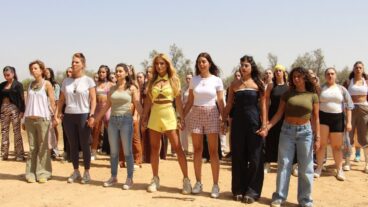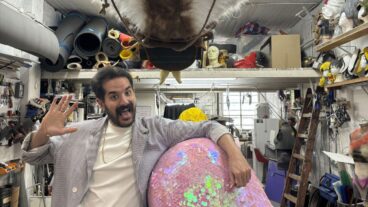New Yorker Celine Alwyn stood outside of one of the venues at Lincoln Center chatting with a friend visiting from the West Coast. Alwyn, a dancer who has appeared on Broadway, goes out to see a lot of dance in general and especially now, during the annual Lincoln Center Festival.
She had seen Israel’s Batsheva Dance Company perform a week earlier and the San Francisco Ballet the previous evening. Tonight, she was bringing a friend to see more dance from Israel, this time to view Yasmeen Godder’s emotionally charged Strawberry Cream and Gunpowder, a dance composition dealing directly with the undercurrents of violence in the Middle East.
“It looked really interesting,” she said. “I was curious about how what they put on paper is going to result on the stage.”
It was an audience sentiment that was often repeated about Israeli dance during the Lincoln Center Festival, which was held from July 10-30. This year, the renowned festival, which features a wide array of dance, theater, music and opera from around the world, featured, for the first time, performances by three Israeli dance troupes – one for each week of the festival.
The three troupes presented at the festival offered sharply different compositions.
Batsheva’s Telophaza was a dazzling main stage spectacular, utilizing nearly 40 dancers and four huge television screens. Emanuel Gat’s Rite of Spring and Winter Voyage set modern dance to classical music, and of course, there was Godder’s haunting Strawberry Cream and Gunpowder.
Nigel Redden, the festival’s director, said that the staging of three very different dance pieces would give audience members an opportunity to experience a wide breadth of dance from the country. “The three choreographers together represent a real picture of this country at this time,” he told ISRAEL21c, “and I think they all should be seen together at this festival.”
John Rockwell, chief dance critic of the New York Times, did just that. As the festival drew to a close, Rockwell, himself a former director of the Lincoln Center Festival, was asked whether he considered dance emanating from Israel to be world-class.
“It’s hard to say [where they rank in the world] because Israel is such a small county, but per capita, it has got to be number one,” Rockwell told ISRAEL21c.
With battles currently raging along the Israeli-Lebanese border, it would come as no surprise that Strawberry Cream and Gunpowder would prove to be the most provocative of the Israeli offerings at the festival.
Godder said that she started the process of composing the piece by bringing in photographs of Israeli-Palestinian violence into the studio. She then placed the dancers into poses that embodied or symbolized the pictures, and let the movement flow from out of that frozen moment, without preconceptions or personal commentary.
Dancer Iris Erez, who performed in the piece, spoke afterwards about the challenges of working with this material.
“I was used to working from the inside out, using my past experiences [to then formulate my movement]. For this, it was actually the other way around. It was trying to be empty and pour into this imagery.”
She said that it was a powerful piece which forced her to address realities which she had numbed herself to.
“It was very meaningful to start dealing with these issues. To bring them into the studio was very powerful and very frightening. [The challenge was] to connect in a very sincere way to imagery that we see all the time and as such, we are sometimes indifferent to.”
Audience member Brooke Budy said that Godder’s work was very effective.
“It made me think about everything that?s going on now,” Budy said.
“This is such a strong piece because of the way that it touched upon the mosaic of a narrator and yet let me go with them to all these other progressions and feelings: War and peace, sex, even the Holocaust,” he said.
In contrast, Rockwell described Telophaza as a “cheerful, superficial sort of almost popsy piece.”
Batsheva choreographer Ohad Naharin told a pre-dance symposium that this was exactly the plan.
“In this particular piece, the lightness was the virtue,” Naharin said. “It was very evident in this piece that we were not taking ourselves too seriously and were demonstrating the ability to laugh at ourselves.”
Rockwell pointed out that while it may have seemed insensitive or incongruous for an Israeli dance company to put on such a show during these difficult times, it was obviously not intentional, as the performance had been booked months in advance, long before the recent escalations of violence in the region.
Rockwell lauded the strong support that the Israeli government has historically given to the arts and how it has served as a kind of cultural ‘diplomacy’.
“[They have a] policy of presenting [the country] to the world as… not some sort of… outpost of people being bombed and rocketed upon all the time but an actual functioning civilization with real culture,” he said.
Rockwell, who has visited Israel on two occasions, can personally attest to the country’s rich culture and considers the government’s backing for touring arts a commendable practice.
“I think it’s perfectly honorable and good. I wish that America did it.”
Rockwell said that he felt that dance was a particularly good medium for Israel to send out to the world, because it was a universal language of movement that transcends boundaries and conveys the special attributes of Israeli society and culture.
“Israeli dance has something uniquely Israeli to offer,” he said.
Moreover, he said, some of it is very good. Rockwell found Gat’s performances, in particular, to be most praiseworthy.
“[The dance to] Stravinsky was good and the Schubert was wonderful… I was really impressed by them. I thought that was really something.”
Elliot Forrest, longtime radio broadcaster and host of the A&E cable television program Breakfast with the Arts, was charmed by a surprise twist during Telophaza, where the audience of nearly 3,000 people were encouraged to get up in their seats and move and dance together with the Batsheva dancers.
“As an audience member, what I found interesting in that moment was that it wasn’t the people were just doing the movements and looking at the dancers,” Forrest said.
“There was a sense that everybody looked around and saw this huge mass of movement… I think that people were astonished by that to a certain degree and enjoyed that.”
It’s interesting to note that Telophaza and Strawberries Cream and Gunpowder each ended with a focus on an individual dance couple. In the lighthearted Batsheva piece, the bodies were entwined lovers, while in Godder’s work, the couple were teetering on the verge of death.
“It’s like Israel,” said audience member Avi Schwartz, reflecting on the way the country at times seems to walk the line between happiness and tragedy.
“And yet the very presence of these dance troupes here [at this troubled time] shows that in spite of all obstacles, the country continues to create, to choose life.”












